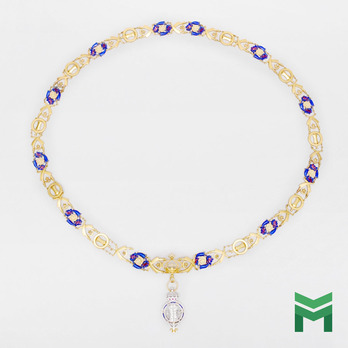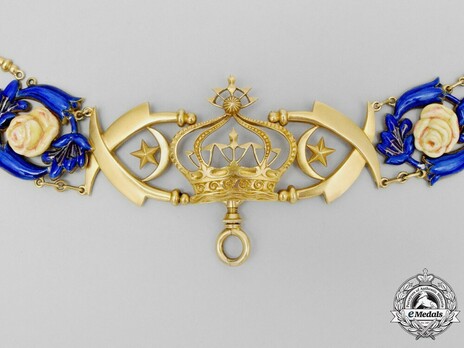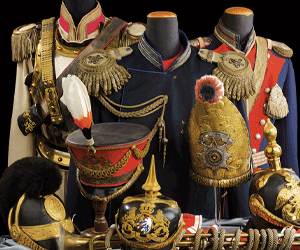Royal Family Order, Collar
SKU: 01.IND.0129.101.01
Estimated market value:


Estimated market value:
Attributes
History
This Order was instituted by Maharaja Bhupinder Singh. It was conferred upon male members of the Phulkian Family.
Although no statutes have been found for the Order, nor has it been determined as to whom it was awarded, it was almost certainly instituted by Maharaja Sir Bhupendra Singh, GCSI, GCIE, GCVO, GBE, the ruling Maharaja of the princely state of Patiala, from 1900 to 1938. It is believed that the Order was only intended for male members of Patiala or related Royal Families and it is possible that the diamond encrusted version was worn uniquely by Bhupendra Singh during grand ceremonies, while the gold and enamel version was worn by him on less formal occasions. Although no ribbon has been identified, it is possible that it would have been dark blue with gold stripes, these being the colours of Patiala State and of the decorations themselves.
Maharaja Sir Bhupendra Singh, GCSI, GCIE, GCVO, GBE was born Bhupinder Singh at the Moti Bagh Palace, in Patiala, a city in southeastern Punjab, in northern India, on October 12, 1891 and was educated at Aitchison College in Lahore. At the age of nine, he succeeded as Maharaja of Patiala state upon the death of his father, Maharaja Rajinder Singh, on November 9, 1900. A Council of Regency ruled in his name until he took partial powers shortly before his eighteenth birthday on October 1, 1909 and was invested with full powers by the Viceroy of India, the 4th Earl of Minto, on November 3, 1910. He served on the General Staff in France, Belgium, Italy and Palestine during the First World War, as an Honourary Lieutenant-Colonel, later promoted to Honourary Major-General in 1918 and Honourary Lieutenant-General in 1931. He represented India at the League of Nations in 1925, and was Chancellor of the Indian Chamber of Princes for ten years, between 1926 and 1938, and was also a representative at the Round Table Conference. He married many times and had many children by his wives and concubines. Maharaja Sir Bhupinder Singh was the first man in India to own an aircraft, which he bought from the United Kingdom in the first decade of the twentieth century. He subsequently had an airstrip built at Patiala to accommodate the aircraft. He was well known for the construction of buildings with bold architectural designs in Patiala, including Kali Temple, Patiala, and Chail View Palace in the summer retreat of Kandaghat, along with Chail Palace and Oak Over and Cedar Lodge in Shimla, which now houses the Chief Minister of Himachal Pradesh and Punjab State Guest House, respectively. He is perhaps the most famous Maharaja of Patiala, best known for his extravagance and for being a cricketer and sportsman. He was also known for an exceptional collection of medals, believed to be the world's largest at the time.
According to legend, Maharaja Sir Bhupinder Singh would be driven in a motorcade of twenty Rolls Royce cars. He had a unique monorail system built in Patiala known as Patiala State Monorail Trainways. He had the world's highest cricket pitch built, at 2,443 metres in 1893 at Chail. His then Education Minister, Pt. Makhan Lal Banerjee, accompanied him to the summer capital of Chail and was also a well-known referee in cricket. His cricket and polo teams, Patiala XI and Patiala Tigers, were among the best of India. He was Captain of the Indian cricket team that visited England in 1911 and played in twenty-seven first-class cricket matches between 1915 and 1937. In the 1926-1927 season, he played as a member of Marylebone Cricket Club. He donated the Ranji Trophy in honour of Kumar Shri Ranjitsinhji, Jam Sahib of Nawanagar. He was selected as the Captain of India on its first Test Tour of England in 1932, but dropped out for reasons of health two weeks before departure, with the Maharaja of Porbandar taking his place. Maharaja Sir Bhupendra Singh's other noted accomplishments included: donating most of the buildings of Chail Military School at Patiala to the Government of India, founding the State Bank of Patiala in 1917, serving as the Chancellor of the Chamber of Princes from 1926 to 1931 and working tirelessly for his subjects' betterment, which included the introduction of many social reforms in Patiala. He married five times and had numerous consorts.
From those unions, he sired an estimated eighty-eight children of whom at least fifty-three survived him. He was the proud owner of the world-famous Patiala Necklace, manufactured by the famous brand Cartier SA. His wife, Maharani Bakhtawar Kaur, presented Queen Mary with a magnificent necklace on behalf of the Ladies of India during the Delhi Durbar of 1911, to mark the first visit to India by any Queen Empress. Of his five married wives, Maharani Vimla Kaur of Patiala, his third Dowger Maharani from Ubbewal was his favourite wife. She attended all the ceremonies with him and travelled abroad. Maharaja Sir Bhupendra Singh died on March 23, 1938, in Patiala, at the age of 46 and was succeeded by Maharaja Yuvraj Yadavindra Singh.

Versions
N/A
Gold/Enamelled
1520mm
Garrard & Co., Calcutta; Garrard & Co., London


Comments
Sign in to comment and reply.


Scroll Top